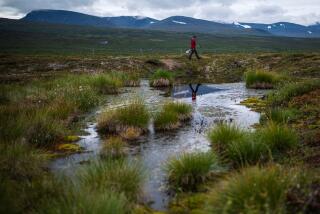Global Warming Linked to Ice Shelf’s Collapse
- Share via
Early last year, scientists trying to track the earth’s climate saw something on satellite photographs that startled them: Nearly 400 square miles of Antarctic ice shelf had disintegrated into the sea.
The collapse was all the more intriguing because it happened when scientists at three research centers in the United States and Europe had begun to conclude independently that a warming of the earth’s atmosphere has been caused at least partly by greenhouse gases that came from burning fossil fuels.
For more than a decade, most of the world’s top climate detectives have theorized that human activities are contributing to a gradual warming that has been recorded since the end of the last century. But they did not have the evidence to move their assertion from theory to reality.
Now, because of improved computer models and a better understanding of atmospheric chemistry, they think they have the goods.
“We are confident that we can see the fingerprint of human activities in the observational record,” said Tom Wigley, a climatologist at the National Center for Atmospheric Research in Boulder, Colo.
The Intergovernmental Panel on Climate Change, comprising more than 2,500 scientists from 55 countries, recently prepared a series of reports that make the strongest case yet that the burning of fossil fuels is contributing to the warming of the earth. The panel advises the United Nations and helps guide signatories to the climate treaty signed in 1992 at the Earth Summit.
Wigley, who is among the group’s lead authors, has worked on computer models with climate experts at the Lawrence Livermore National Laboratory. The first studies were done there to show that actual temperature changes agreed with computer predictions based on increases in greenhouse gases.
Similar studies were completed last year by climate modelers at the Max Planck Institute in Hamburg, Germany, and at the British Meteorological Office’s Hadley Centre for Climate Prediction and Research.
“Both those organizations have run their own models, and have carried out these pattern-recognition studies, and have come to the same conclusions,” Wigley said.
In trying to find out if the burning of fuels has contributed to the warming that has already occurred, the scientists have used the computer models to reproduce the climate during the last century. The simulations have included the increasing emissions of carbon dioxide into the atmosphere.
Initially, the computer models produced more warming than has been documented.
But there was something missing in the models, the scientists at the three sites eventually discovered.
They were not accounting for sulfate aerosols, which are also byproducts of combustion but which have a cooling effect by reflecting some sunlight back into space.
When the scientists added the aerosols to their simulations, “lo and behold, you can see the correspondence between the models and the observations,” Wigley said. “It’s only in the last few years that we’ve done these combined experiments.”
Some scientists still don’t view the findings as meaningful.
They say it is hardly surprising that human beings are having an effect on the global environment.
“Most scientists who have looked at this will say, ‘Yes, you can see signals.’ The real problem is, why are they so small? They’re tiny, they’re minuscule,” said Patrick Michaels, a climatologist at the University of Virginia.
Michaels edits a climate-change newsletter that is funded by a company that supplies fuel to various utilities.
“It is obvious that this story is blown out of proportion,” he said.
There is no debate that carbon dioxide comes mainly from the burning of fossil fuels, such as coal and oil, and from deforestation. It is the most abundant of the greenhouse gases.
Others include nitrous oxide, from fertilizers and burning fuels, and naturally occurring methane, which comes from sources as diverse as rotting garbage in landfills and emissions from cows.
Artificial chlorofluorocarbons, the refrigerants blamed for damaging the earth’s protective ozone layer, account for a smaller portion of the total.
The gases, the scientists say, act like the panes of glass in a greenhouse, allowing sunlight in but not allowing as much heat to escape. This so-called greenhouse effect is enhanced when concentrations of the gases increase.
Before the Industrial Age, atmospheric concentrations of carbon dioxide were about 280 parts per million.
Today the concentration is about 360 parts per million.
The intergovernmental panel previously has said that, if carbon dioxide emissions were maintained at current levels, atmospheric concentrations of the gas would reach about 500 parts per million by the end of the next century.
In the last century, the earth’s average surface-air temperature rose by about 1 degree Fahrenheit.
If carbon dioxide emissions are maintained at 1990 levels, the panel says, the average temperature could be expected to rise by 3 to 8 degrees by the end of the next century.
Wigley projects an increase closer to about 4 degrees.
That might not sound like much, but it would amount to a warming rate four times that observed in the last century, Wigley said. By another comparison, scientists estimate that the earth’s average surface temperature has warmed by 5 to 9 degrees Fahrenheit since the peak of the last ice age 18,000 years ago.
If the growing number of scientists who agree with the panel’s projections are right, then coastal areas such as Connecticut’s shoreline can expect the sea to rise by almost 2 feet in the next century.
Areas along the coast could be eroded and flooded more than in the past, and they could be made more vulnerable to storms and storm surges.
Many coastal wetlands and marshes, the areas that serve as nurseries for all kinds of fish and other marine species, could be lost.
Much more severe disruptions could occur in places such as the Horn of Africa and eastern Brazil.
Deserts of the world could expand, and growing seasons and soil conditions could be altered, leading to reductions in the yields of some crops and increases in others.
The disintegration of a portion of the Antarctic ice shelf, although not evidence of global warming, could be a sign of the types of events to come in a warmer world.
Then again, it might be the result of warmer temperatures observed in one part of Antarctica--a rise of more than 4 degrees Fahrenheit during the last half-century--that has not been matched in other parts of the continent.
David Vaughan, a glaciologist in Cambridge, England, spotted the change in Antarctica in January and February of 1995, as he studied satellite photographs.
He has been careful to note in published accounts of the collapse that he is not sure whether it is part of a trend that’s occurring on a larger scale.
Michael Oppenheimer, senior scientist at the Environmental Defense Fund and another global-warming expert, said the collapse is another sign that things are warmer.
“And it’s a reminder of what warming does. But whether the overall ice shelf is less stable, we don’t know yet,” he said.
“I think the bottom line is, the climate is changing, human beings appear to be influencing the climate for the first time, and . . . if this influence isn’t restrained, we could wind up with a world in the next century that is difficult for civilization and impossible for many natural ecosystems to adapt to,” Oppenheimer said.






